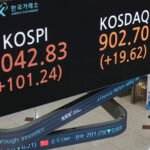Samsung Electronics new image sensors (Courtesy of Samsung Electronics)
Samsung Electronics Co. has developed new image sensors — ISOCELL HP9, ISOCELL JN5 and ISOCELL GNJ — expected to enable smartphones to take clearer photos with more vivid color, the company said on Thursday.
An image sensor is a semiconductor that converts light coming through a camera lens into digital data. The quality of the image sensor highly affects a camera’s performance.
South Korea’s chip giant’s new image sensors are powered by its leading 200-megapixel (MP) and 50MP technologies, which significantly enhance the performance of both primary and secondary cameras in mobile phones to ensure excellent imaging from every angle, said the company.
“Enhancing image sensor performance and bridging the gap between main and sub cameras to offer a consistent photography experience across all angles is the new direction of the industry,” Jesuk Lee, executive vice president and CTO of the System LSI Sensor Business Team at Samsung Electronics, said in a statement.
VIVID COLOR AND CLEAR PICTURES ACROSS ALL ANGLES
The ISOCELL HP9 is the industry’s first 200-MP telephoto sensor for smartphones, said the company said.
Samsung Galaxy S23 Series (Courtesy of Samsung Electronics)
It features 200 million 0.56-micrometer (μm) pixels in a 1/1.4-inch optical format, which enhances camera’s light-gathering capability to ensure vivid color reproduction, according to Samsung Electronics.
The sensor also excels in low-light conditions, while its large optical format makes it perfect for telephoto modules in line with the latest trend preferring bigger sizes for main cameras in premium smartphones.
The ISOCELL GNJ is a dual-pixel sensor with 50 million 1.0 μm pixels in a 1/1.57-inch optical format, and its each pixel houses two photobodies, ensuring fast and accurate autofocus, explained Samsung Electronics.
The sensor is also powered by the newly improved high-transmittance anti-refractive layer, the company’s proprietary high-refractive microlens and an upgraded pixel isolation material in deep trench isolation, which ensure more accurate photos with more detailed and precise images.
The ISOCELL JN5 features dual vertical transfer gate (Dual VTG) technology, which helps reduce noise in extremely low light conditions for clearer image quality, according to the company.
The sensor also leverages Super Quad Phase Detection (Super QPD) to enhance its high dynamic range (HDR) to produce a broader color range.
The Korean chip maker has been striving to narrow the gap with Sony Corp. in the global image sensor market with ultra-high resolution image sensors.
The Japanese peer is an unrivaled leader, commanding about 50% of the market, while the Korean peer controled less than 20% as the runner-up as of late 2023.
By Chae-Yeon Kim
why29@hankyung.com
Sookyung Seo edited this article.















